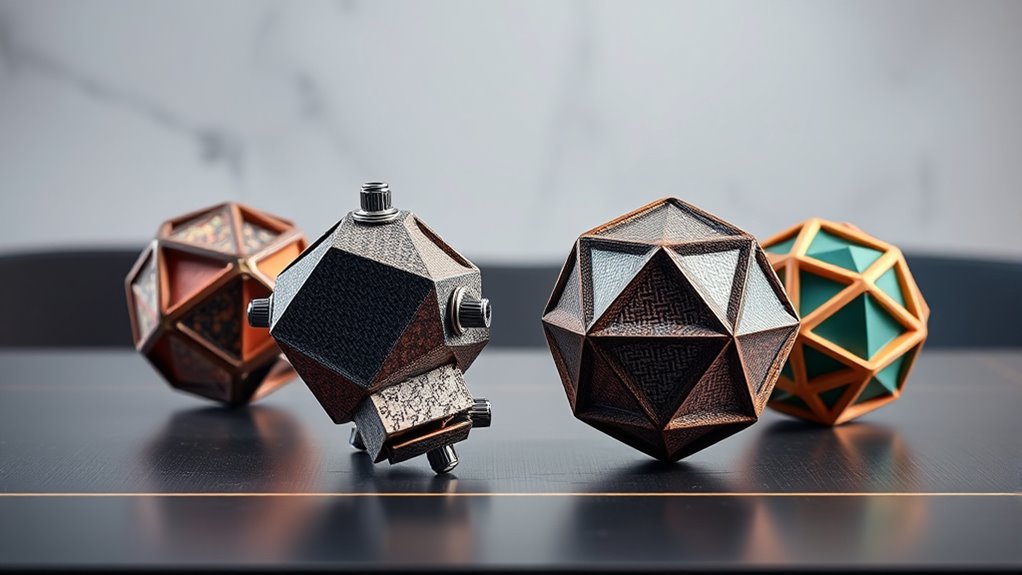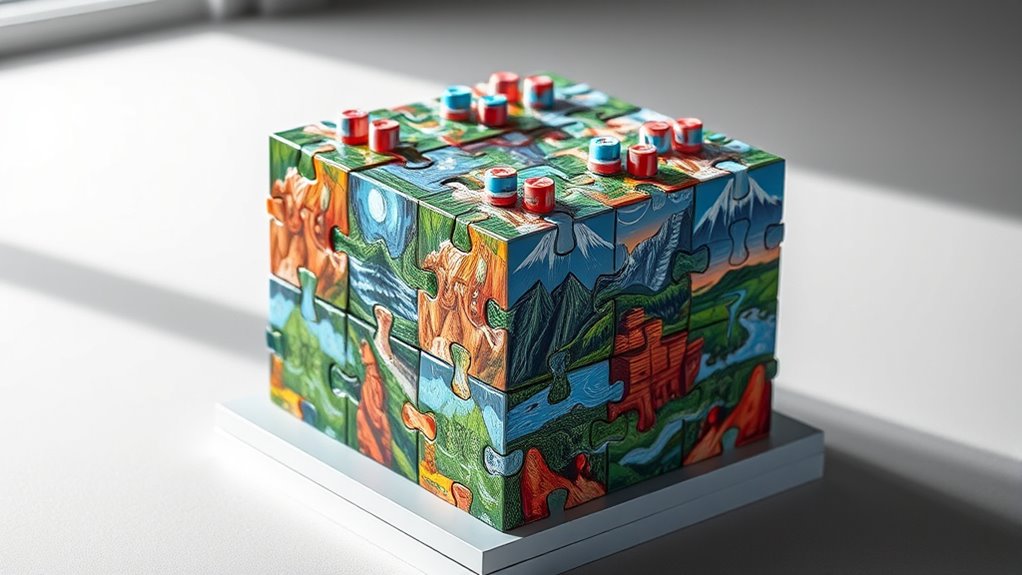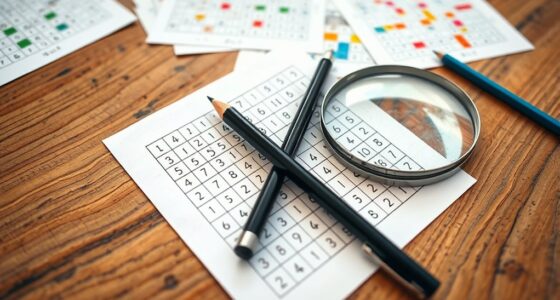To connect multiple 3D puzzles into a modular display, use interlocking mechanisms designed for puzzle integration. These can include custom connectors, clips, or specially designed puzzle pieces that fit together securely. Arrange your puzzles in a way that forms a cohesive flow, and consider using a supportive framework to keep everything stable. By mastering these techniques, you’ll be able to create versatile, eye-catching displays that can be easily customized and expanded. Keep exploring to discover more tips for seamless assembly.
Key Takeaways
- Use interlocking mechanisms designed for puzzle modules to securely connect individual pieces seamlessly.
- Plan your layout beforehand to determine the most stable and visually appealing arrangement.
- Assemble sections separately, then join them together to create a cohesive display.
- Incorporate modular support structures or frames to enhance stability and flexibility.
- Regularly check connections and adjust as needed to maintain alignment and visual flow.

Creating modular puzzle displays allows you to design versatile and eye-catching setups that can be easily customized for any space or event. When you’re working with multiple 3D puzzles, the key to a seamless display lies in understanding how to connect these pieces effectively. Interlocking mechanisms are essential tools in this process, serving as the backbone of a sturdy and adaptable display. These mechanisms enable you to join individual puzzle modules securely, creating a cohesive visual flow without the need for adhesives or complex tools. By choosing puzzles with compatible interlocking features, you can effortlessly assemble and disassemble sections, making your display flexible for different venues or themes.
Modular puzzle displays are easily customizable using interlocking mechanisms for versatile, stable, and portable setups.
In terms of display case design, integrating interlocking mechanisms offers a significant advantage. Instead of constructing a fixed, bulky structure, you can build a modular framework that adjusts to your needs. For example, stacking or aligning puzzles side-by-side becomes simplified when each piece fits snugly into the next. This approach not only enhances stability but also allows for dynamic arrangements. You can design a multi-layered exhibit or a sprawling setup that can be reconfigured with minimal effort. Think of your display as a living structure—one that adapts as your collection grows or as your event requires a new presentation style.
Moreover, incorporating interlocking mechanisms into your display case design supports better organization and presentation. You can create distinct sections or themes within your display, easily separating different puzzle sets or highlighting specific features. This modularity helps visitors focus on individual pieces or appreciate the entire collection without feeling overwhelmed. Plus, if you need to transport or store your display, the ability to disassemble it into smaller, manageable sections makes handling much simpler. It reduces the risk of damage and saves space, making your display setup and takedown more efficient.
The beauty of a modular puzzle display lies in its adaptability. Whether you’re showcasing at a gallery, a trade show, or a classroom, the interlocking mechanisms give you the flexibility to customize your setup quickly. You can create a compact, elegant arrangement or a sprawling, intricate scene, depending on your audience and space constraints. This versatility is especially valuable when working with multiple 3D puzzles, as it allows you to highlight different features or themes without starting from scratch each time. Ultimately, mastering display case design with interlocking mechanisms empowers you to craft engaging, professional-looking presentations that can evolve with your collection and your vision.
Frequently Asked Questions
How Do I Ensure Stability When Connecting Multiple Puzzles?
To guarantee stability when connecting multiple puzzles, focus on proper weight distribution and secure fastening. Distribute the weight evenly across the entire display to prevent tipping or shifting. Use strong connectors or clips that firmly hold each puzzle piece together, and consider adding a stabilizing base or framework for extra support. Regularly check the connections to make sure they remain tight, ensuring your display stays steady and secure.
Can Modular Puzzle Displays Be Customized for Different Themes?
Think of your modular puzzle display as a blank canvas waiting for your unique story. You can absolutely customize it for different themes by incorporating themed designs and color coordination that reflect your vision. Just like an artist chooses colors and elements to match a mood, you tailor each module to fit your theme, creating a cohesive and engaging visual experience that draws viewers into your story.
What Materials Are Best for Durable Puzzle Connectors?
You should choose durable materials like high-quality plastic or metal for puzzle connectors, as they provide strength and longevity. Use interlocking mechanisms designed for a secure fit, ensuring stability when connecting modules. Additionally, consider adhesive options like strong epoxy or industrial-grade glue to reinforce connections where needed. These materials and methods help create a sturdy, reliable modular display that withstands handling and time.
How Do I Store or Transport a Modular Puzzle Display Safely?
To store or transport your modular puzzle display safely, use sturdy storage solutions like padded boxes or custom foam inserts that fit your puzzle pieces snugly. Secure each module with interlocking clips or padding to prevent shifting during transportation. Keep the display in a climate-controlled environment to avoid damage from humidity or temperature changes. Follow these transportation tips, such as handling with care and avoiding stacking heavy objects, to protect your display during movement.
Are There Specific Tools Recommended for Assembling Modular Displays?
You’ll want reliable tools for assembling your modular display, like a screwdriver for interlocking mechanisms and precision applicators for adhesive options. A small level guarantees perfect alignment, preventing your display from turning into a rollercoaster ride. Use clamps or weights to hold pieces steady as the glue dries. Investing in these tools makes assembly smoother, faster, and guarantees your display stays beautifully intact—no matter how much it’s admired or moved!
Conclusion
Now that you’ve learned how to connect multiple 3D puzzles into stunning modular displays, you’re set to craft something truly special. With a bit of patience and creativity, your arrangements can become heartfelt showcases of your dedication and passion. Remember, each piece you connect adds a touch of magic, turning simple puzzles into cherished masterpieces. Embrace the journey, and let your unique vision shine through every carefully placed connection.









